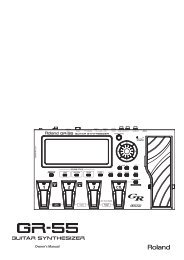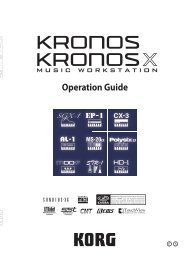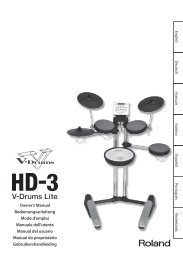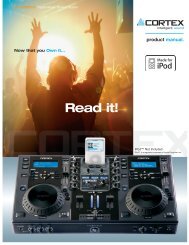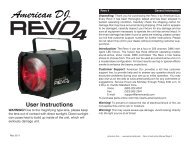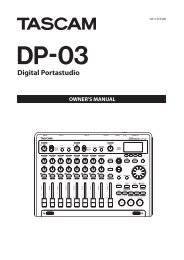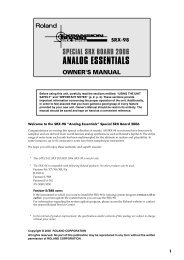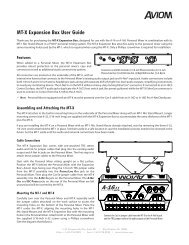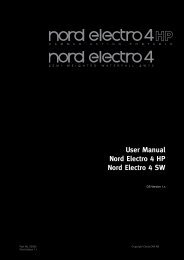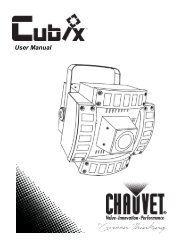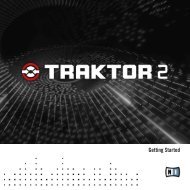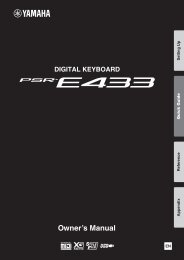Korg Microkorg Owner's Manual - zZounds.com
Korg Microkorg Owner's Manual - zZounds.com
Korg Microkorg Owner's Manual - zZounds.com
Create successful ePaper yourself
Turn your PDF publications into a flip-book with our unique Google optimized e-Paper software.
3. OSC1 (Oscillator 1) — SYNTH/VOCODER<br />
WAVE CONTROL 1 CONTROL 2<br />
DWGS ( )<br />
(Digital Waveform Generator System):<br />
This is waveform data created by<br />
harmonic additive synthesis.<br />
Choose this when you want to create<br />
sounds with a distinctive "digital-synth"<br />
character, such as synth<br />
bass, electric piano, bell, or horn. 64<br />
types of waveform are provided.<br />
Noise ( ):<br />
This generates white noise. Within<br />
the oscillator, a LPF (Low Pass Filter)<br />
is provided to process the noise.<br />
(➝Figure 3-6). You can use this to<br />
create percussion sounds, or sound<br />
effects such as surf. This can also be<br />
used in conjunction with another<br />
timbre to simulate the "breath" <strong>com</strong>ponent<br />
of a wind instrument sound.<br />
CONTROL 1 [– – –]:<br />
– – –<br />
CONTROL 1 [0...127]:<br />
This sets the cutoff frequency of the<br />
LPF.<br />
Adjusting this will affect the noise<br />
waveform.<br />
Figure 3-6<br />
Noise<br />
Genarator<br />
Resonance<br />
LPF<br />
Cutoff<br />
CONTROL 2 [1...64]:<br />
Selects the DWGS waveform.<br />
(➝Table 3-1)<br />
DWGS waveform data was first<br />
used in the <strong>Korg</strong> DW-6000<br />
(which went on sale in 1984),<br />
and has continued to be developed<br />
since that time.<br />
CONTROL 2 [0...127]:<br />
This controls the resonance of the<br />
LPF.<br />
If you raise this enough to produce<br />
an identifiable pitch, the cutoff frequency<br />
will move according to the<br />
keyboard location you play, and the<br />
change will be heard as a pitch.<br />
If you want the oscillation produced<br />
by resonance to match the<br />
reference pitch, set "CONTROL<br />
1" to 24.<br />
Table 3-1<br />
DWGS List<br />
No. Name No. Name No. Name<br />
1 SynSine1 24 5thWave1 47 Clav1<br />
2 SynSine2 25 5thWave2 48 Clav2<br />
3 SynSine3 26 5thWave3 49 Guitar1<br />
4 SynSine4 27 Digi1 50 Guitar2<br />
5 SynSine5 28 Digi2 51 Guitar3<br />
6 SynSine6 29 Digi3 52 Bass1<br />
7 SynSine7 30 Digi4 53 Bass2<br />
8 SynBass1 31 Digi5 54 Bass3<br />
9 SynBass2 32 Digi6 55 Bass4<br />
10 SynBass3 33 Digi7 56 Bass5<br />
11 SynBass4 34 Digi8 57 Bell1<br />
12 SynBass5 35 Endless* 58 Bell2<br />
13 SynBass6 36 E.Piano1 59 Bell3<br />
14 SynBass7 37 E.Piano2 60 Bell4<br />
15 SynWave1 38 E.Piano3 61 Voice1<br />
16 SynWave2 39 E.Piano4 62 Voice2<br />
17 SynWave3 40 Organ1 63 Voice3<br />
18 SynWave4 41 Organ2 64 Voice4<br />
19 SynWave5 42 Organ3<br />
20 SynWave6 43 Organ4<br />
21 SynWave7 44 Organ5<br />
22 SynWave8 45 Organ6<br />
23 SynWave9 46 Organ7<br />
*: The 35 Endless waveform simulates an endless<br />
scale, in which notes one octave apart have the identical<br />
pitch. You can play an ascending or descending<br />
scale as far as you wish, producing the sensation<br />
that a scale of the same pitch is continuing infinitely.<br />
20



